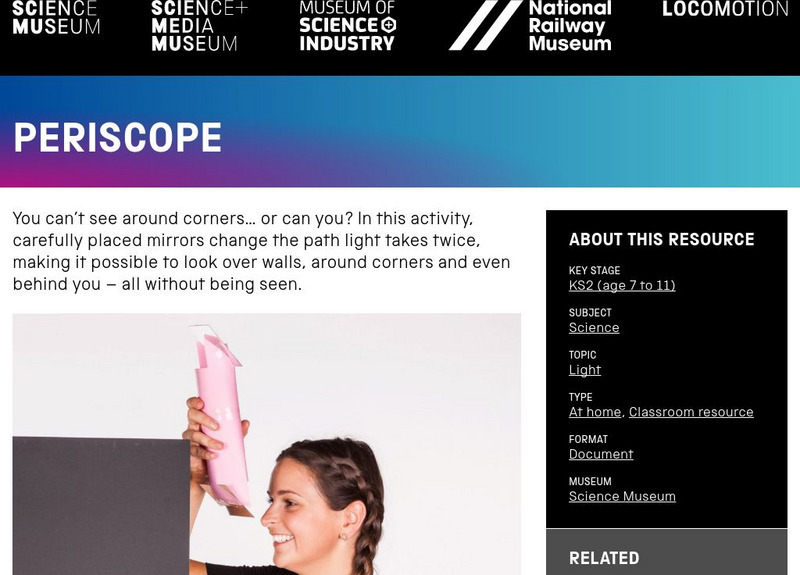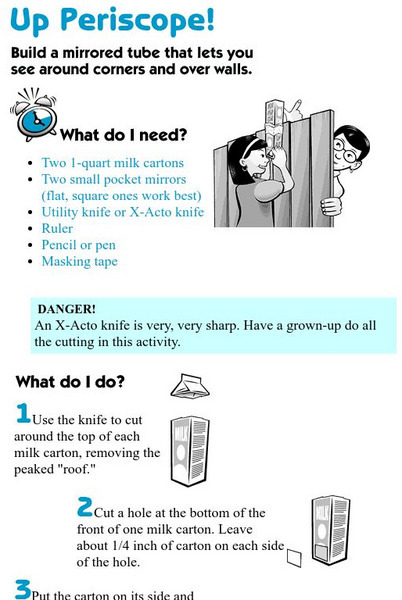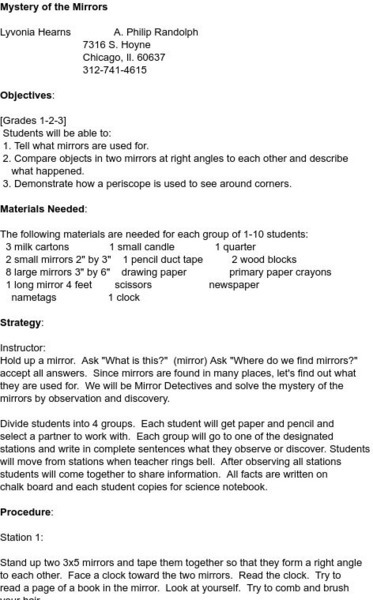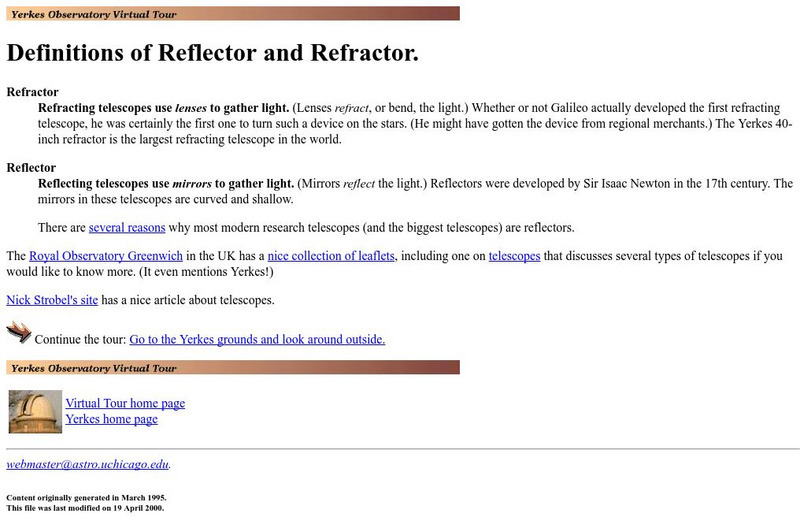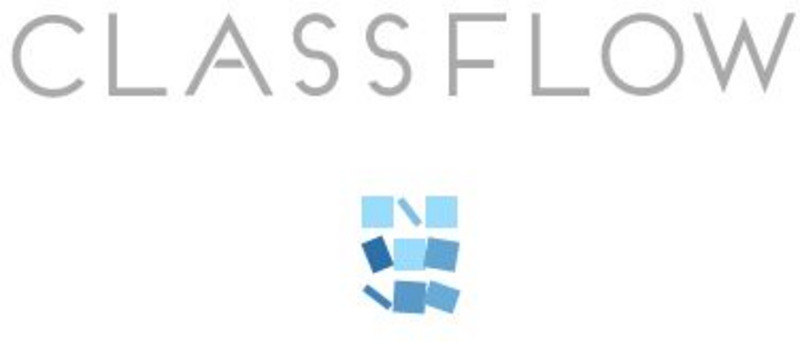Physics Classroom
The Physics Classroom: Reflection and Mirrors: Optics Bench Interactive
Find out about the physics behind those fun-house mirrors. Students manipulate a virtual optics bench to explore the images formed by mirrors and lenses.
Khan Academy
Khan Academy: A Mirror in an Operating Room
This passage will test your knowledge on spherical mirrors.
Pennsylvania State University
Penn State Graduate Program in Acoustics: Reflection From Mirrors
Included here are illustrations of reflections from a plane mirror, a concave mirror and a convex mirror.
Optical Society
Optical Society of America: Optics for Kids: Mirrors and Images
An experiment to investigate how many images appear as the angle between two hinged mirrors is increased. Accompanied by an explanation of what is happening, questions for students to consider, and a link to an article about reflection.
University of New South Wales (Australia)
University of New South Wales: School of Physics: Physclips: Geometrical Optics
Physiclips thoroughly presents geometrical optics concepts like rays, refraction, Snell's law, total internal reflection, dispersion, mirrors, and lenses with animations and film clips.
Physics Classroom
The Physics Classroom: Reflection and the Ray Model of Light: Ray Diagrams
This illustrated physics tutorial serves as a step-by-step guide to drawing ray diagrams. It includes an opportunity for students to practice and check their answers.
Science Museum, London
Science Museum: 360 Periscope
Make a 360 degrees periscope which uses mirrors to reflect light to see around corners.
Science Education Resource Center at Carleton College
Serc: Mn Step: Reflection Race: Exploring Reflection of Light
An interesting and engaging activity where students work in groups with a laser pointer and small mirrors. They must use their knowledge of angles of reflection to bounce the laser beam from mirror to mirror until it hits a target at the...
Physics Classroom
The Physics Classroom: Reflection and Ray Model of Light: Spherical Aberration
An illustrated physics tutorial which explains the spherical aberration, an intrinsic defect with any mirror that takes on the shape of a sphere.
University of Maryland
Optics Highlights: The Telescope
Part of an anecdotal history of optics and the study of light. Extremely thorough treatment of the invention of the telescope. Includes a short biographical sketch and discusses the work of Isaac Newton which focuses on his contribution...
CK-12 Foundation
Ck 12 Exploration Series: Simulations: Physics: Prom Night
[Free Registration/Login Required] Understand the Law of Reflection by plane mirrors and the formation of virtual images. Use the simulation to play with variables for a variety of reflections. Further examples explaining how mirrors...
Science and Mathematics Initiative for Learning Enhancement (SMILE)
Smile: Plane, Concave, Convex Mirrors (Intermediate)
This lesson plan describes a demonstration with mirrors to catch the interest of students. Should be used with intermediate or middle school students.
Georgia Department of Education
Ga Virtual Learning: Optics
Students discover how mirrors affect optics in this module through reading informational text, watching animations, and answering self-checking practice questions.
TeachEngineering
Teach Engineering: Security System Design
Middle schoolers apply everything they have learned about light properties and laser technologies to designing, constructing and presenting laser-based security systems that protect the school's mummified troll. In the associated...
Bill Nye
Bill Nye: Mirror, Mirror
In this tutorial, Bill Nye uses a mirror to help the learner understand how our brain processes images.
Exploratorium
Exploratorium: Science Snacks: Look Into Infinity
In this activity students will create images of images of images that can repeat forever. Students will recreate this effect by setting up two acrylic plastic mirrors.
My Science Site
Optics: Energy and Control [Pdf]
A very comprehensive unit including topics such as light and its source, visible sources of light, transparency of objects and much more. Also offers a resource list, blackline masters, and expectation list, expectation summary and a...
Exploratorium
Exploratorium: Up Periscope!
Children can look around corners with this homemade periscope. Great instructions at this Exploratorium site on how to build a periscope.
Other
The Disgustoscope
This is a resource to teach optics, while building a modified kaleidoscope that will provide 3-dimensional images.
Science and Mathematics Initiative for Learning Enhancement (SMILE)
Smile: Mystery of the Mirrors (1 3)
This lesson plan from the Illinois Institute of Technology incorporates observation with hands on activity through various stations.
TeachEngineering
Teach Engineering: Construct It!
Students use simple household materials, such as PVC piping and compact mirrors, to construct models of laser-based security systems. The protected object (a "mummified troll" or another treasure of your choosing) is placed "on display"...
University of Chicago
University of Chicago: Reflector and Refractor
From the Yerkes Observatory Virtual Tour web site. Compares and contrasts reflecting and refracting telescopes. A link from the page leads to a second page which explains why most modern research telescopes are reflecting telescopes.
ClassFlow
Class Flow: How We See Things
[Free Registration/Login Required] In this unit children learn that mirrors and shiny surfaces alter the direction in which light travels and that when they see objects light enters the eye. Children contrast reflection and shadow...
Boston University
Bu: Optics: Geometric Optics
Several short descriptions of demonstrations which illustrate principles of geometric optics (many of which focus upon refraction).





